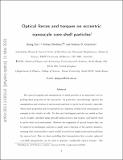Optical forces and torques on eccentric nanoscale core–shell particles
Abstract
The optical trapping and manipulation of small particles is an important tool for probing fluid properties at the microscale. In particular, microrheology exploits the manipulation and rotation of micron-scale particles to probe local viscosity, especially where these properties may be perturbed as a function of their local environment, for example in the vicinity of cells. To this end, birefringent particles are useful as they can be readily controlled using optically induced forces and torques, and thereby used to probe their local environment. However, the magnitude of optical torques that can be induced in birefringent particles is small, and a function of the particle diameter, meaning that rotational flow cannot readily be probed on length scales much small than the micron level. Here we show modeling that demonstrates that eccentric spherical core–shell nanoparticles can be used to generate considerable optical torques. The eccentricity is a result of the displacement of the center of the core from the shell. Our results show that, for particles ranging from 90 to 180 nm in diameter, we may achieve rotation rates exceeding 800 Hz. This fills a missing size gap in the rotation of microparticles with optical forces. The diameter of particle we may rotate is almost an order of magnitude smaller than the smallest birefringent particles that have been successfully rotated to date. The rotation of eccentric core–shell nanoparticles therefore makes an important contribution to biophotonics and creates new opportunities for rheology in nanoscale environments.
Citation
Sun , Q , Dholakia , K & Greentree , A D 2021 , ' Optical forces and torques on eccentric nanoscale core–shell particles ' , ACS Photonics , vol. 8 , no. 4 , pp. 1103–1111 . https://doi.org/10.1021/acsphotonics.0c01825
Publication
ACS Photonics
Status
Peer reviewed
ISSN
2330-4022Type
Journal article
Description
Funding: Q.S. and A.D.G. acknowledge support of the Australian Research Council Centre of Excellence for Nanoscale BioPhotonics (CNBP; Grant No. CE140100003), K.D. acknowledges the UK Engineering and Physical Sciences Research Council (Grant EP/P030017/1), Q.S. acknowledges the support of an Australian Research Council Discovery Early Career Researcher Award (Grant No. DE150100169), and A.D.G. acknowledges the support of an Australian Research Council Future Fellowship (Grant No. FT160100357). This research was undertaken with the assistance of resources from the National Computational Infrastructure (NCI Australia), an NCRIS enabled capability supported by the Australian Government (Grant No. LE160100051).Collections
Items in the St Andrews Research Repository are protected by copyright, with all rights reserved, unless otherwise indicated.

